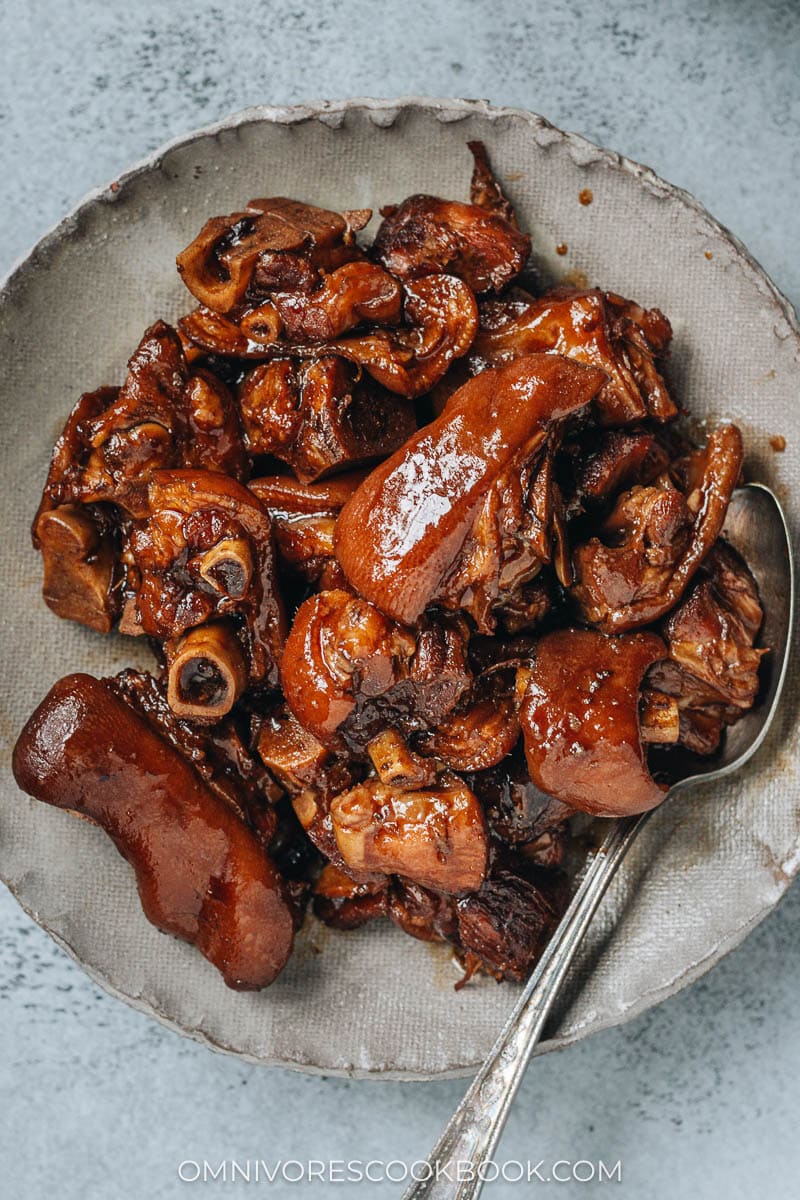
Chinese cuisine is known for utilizing different parts of the whole animal to create delicious meals. For example, chicken liver and pork liver are used to create tasty stir fries. Oxtail makes a super luxurious stew. Beef tripe, lung and tongue with red chili oil makes a rich tasting cold appetizer. Bones are often made into hearty bone broth for noodle soup and stews.
Braised pork trotters is one of my favorite homestyle dishes that my mom has been making since I was a kid. The trotters are carefully boiled first to remove the impurities. They’re cooked until very tender in a pressure cooker, then braised with aromatics and sauces to achieve a rich, savory flavor. The end dish is fall-off-the-bone tender but doesn’t taste greasy at all. The connective tissue becomes so tender, and the lean meat in between just melts in your mouth. On top of steamed rice, it makes a satisfying main dish without breaking the bank.
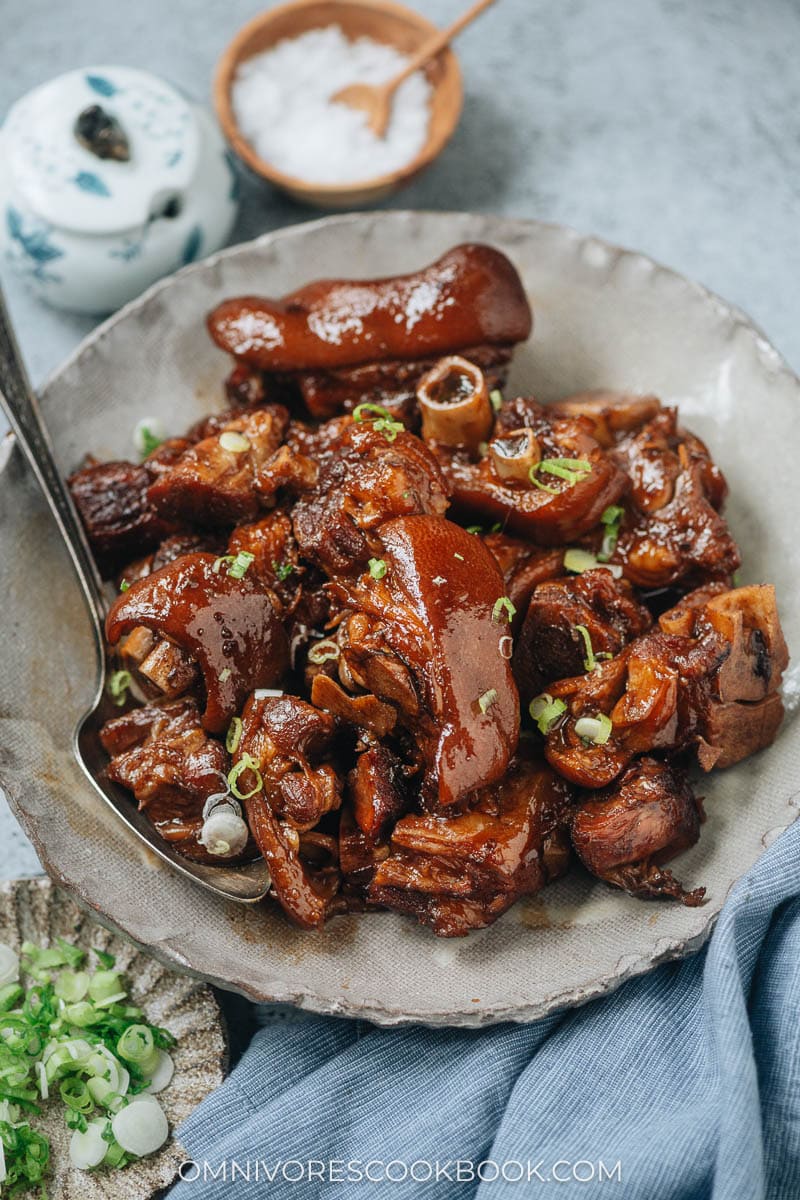
Braised pork trotters ingredients
Pork trotters
You can find pork trotters at most Chinese markets and Asian online grocery deliveries. These days, most shops sell the pre-cut trotters that you can cook directly. If you’re purchasing whole trotters, make sure to let the butcher cut them into large bite-size pieces (they usually cut one trotter into 6 pieces). The butcher has a very sharp saw to make clean cuts, which is much nicer than chopping them at home using a cleaver.
Mise en place
Making braised pork trotters requires a few common pantry ingredients:
- Pork trotters, cut into small pieces
- Aromatics: ginger and green onion
- Spices: star anise, clove, dried chili pepper
- Sauce: dark and light soy sauce, Shaoxing wine, sugar and salt

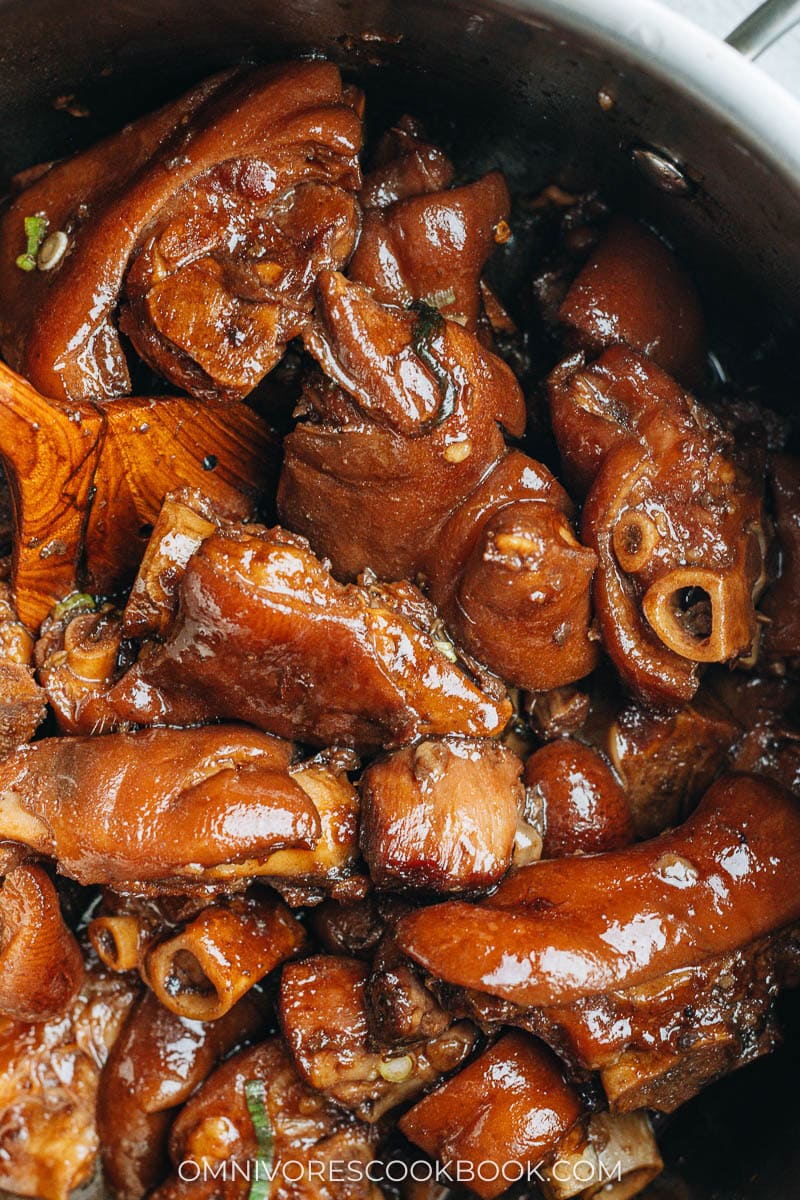
I used rock sugar in this recipe, which gives the sauce a more glossy look. You can use regular sugar as well.

Dark soy sauce is used in this recipe to add an appetizing dark brown color to the sauce. If you don’t have it on hand, you can use regular soy sauce (with a touch of molasses if you have it). The sauce will come out with a lighter color but still be delicious.
Cooking process
Cooking braised pork trotters is quite easy, but it involves a bit of passive waiting time. That’s why I usually prefer to make a large quantity at one time and freeze the portion that I plan to serve later.
- Start the cooking with pork trotters, cold water and ginger
- Once boiling, skim the brown bits off the top
- Boil and skim until the broth almost runs clear
- Transfer the trotters with some of the broth into an Instant Pot or pressure cooker
- Pressure cook until the trotters turn tender
- Move the trotters and the broth to a large pot to cook on the stovetop
- Simmer with aromatics, spices and sauce
- Cook until the pork has become flavorful and super tender
- Reduce the sauce so it becomes thick and glossy
- Add back the pork and mix well
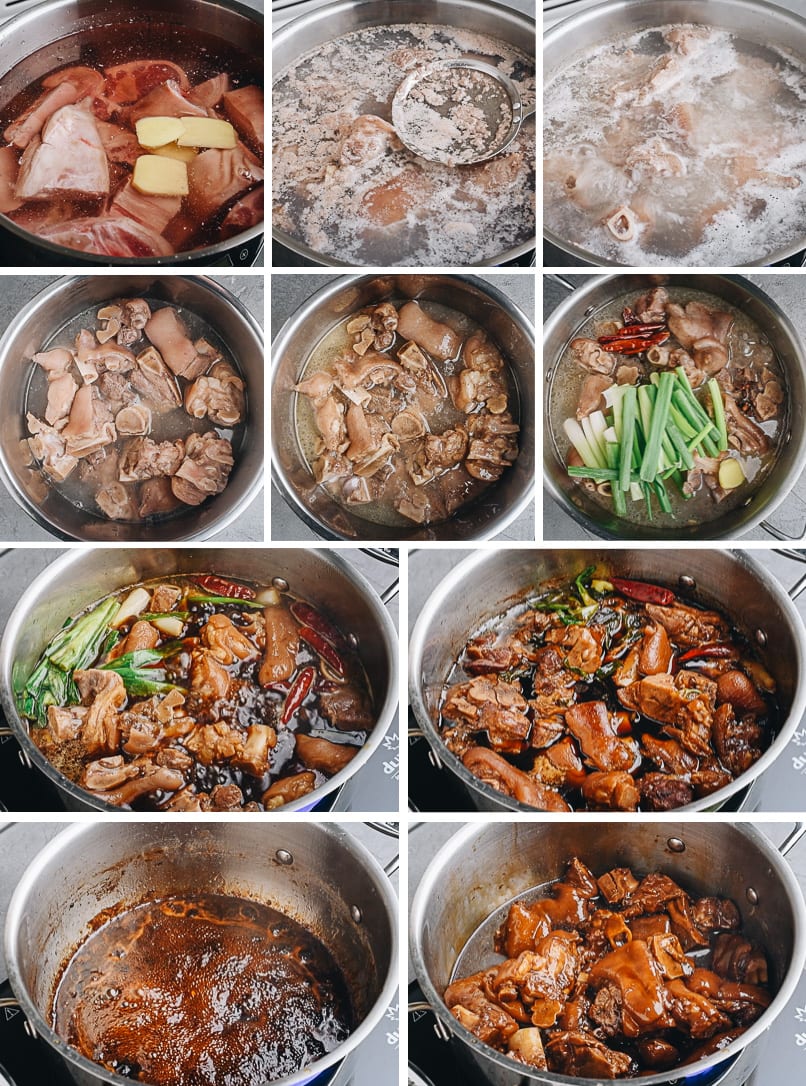
The whole cooking process does take some time, but most of it is passive. I highly recommend making the dish on the weekend, so you won’t be in a hurry and can use the time in between to do other things.
Frequently asked questions
Can I cook braised pork trotters without an Instant Pot?
Yes! It is quite easy to do so but will require a longer cooking time. It will take about 2 hours to simmer the pork in this case.
If you do cook this dish on the stove, I would also add the aromatics and spices at the beginning (once you finish skimming the broth). Then add the sauce ingredients after 1 hour. This will give the pork an even richer taste.
Do I have to reduce the sauce at the end?
I took the extra step of removing the pork from the pot and reducing the sauce, so the sauce will be thick and glossy. The thicker sauce stays on the pork better and gives it a richer flavor.
To simplify this step, you can leave everything in the pot and use high heat to slightly reduce the sauce at the end. In this case, make sure to constantly stir the pot, so the pork won’t stick to the bottom.
It’s also totally OK to not reduce the sauce at all, if you’re happy with the seasoning the way it is.
How to serve braised pork trotters
I always love to serve braised pork trotters over a bowl of steamed rice. Although some Chinese restaurants also serve them in noodle soup. Check out this simple tomato noodle soup recipe if you want to serve the trotters over noodles.
Since braised pork trotters are so rich tasting, I would pair them with a simple side dish such as Fried Cabbage, Baby Bok Choy Stir Fry, Spinach and Peanuts Salad, or Cucumber Salad.
How to reheat and store braised pork trotters
I like to store the extra portion in small containers in the freezer. They stay good for 3 to 4 months. To reheat, the best way is to thaw them overnight in the fridge, then heat them up thoroughly in a steamer. If you haven’t reduced the sauce much, you can also reheat them in a small pot over medium-low heat (you need to stir frequently to prevent it from sticking).
It’s possible to directly reheat them without thawing first, but it will take longer.
Do not heat the trotters in a microwave. The skin and connective tissue don’t heat well and will make explosive sounds. The dish will end up heating up unevenly and leave a mess in your microwave.
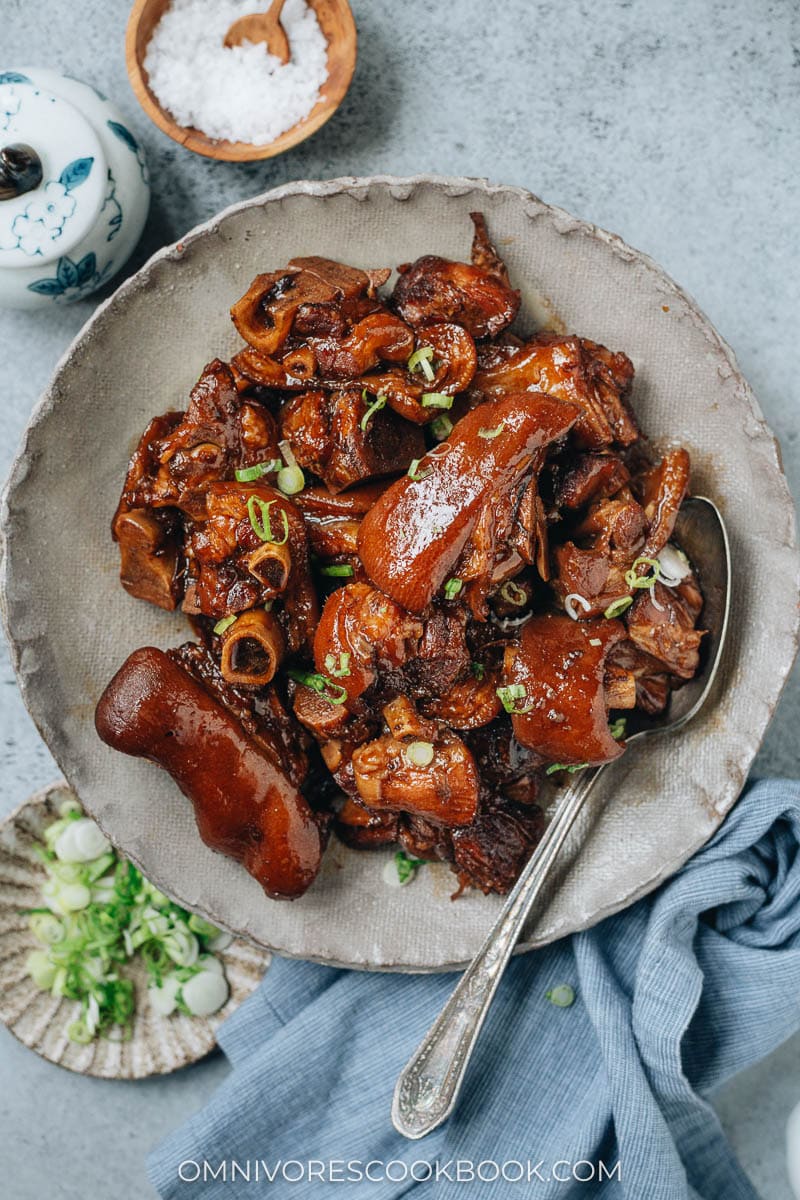
Other delicious make ahead main dishes
- Instant Pot Curry Beef Stew
- Chinese Chicken Dumplings (鸡肉饺子)
- Coca-Cola Chicken Wings (可乐鸡翅)
- Instant Pot Chinese Sausage Rice (腊肠饭)
- Easy Salt Baked Chicken (简易盐焗鸡)
- Chinese Braised Beef Shank (酱牛肉, Jiang Niu Rou)
Chinese Cooking Made Easy
Are you new to this website? This free email series is a great place to start. I’ll walk you through a few of my most popular recipes and show you how and why they work. You’ll quickly start to cook better Chinese food in your own kitchen.
Watch video
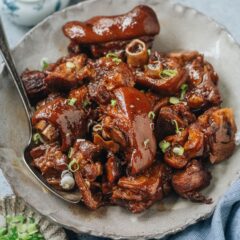
Chinese Braised Pork Trotters (红烧猪蹄)
Ingredients
- 3 to 4 lb pork trotters , cut into large cubes (*Footnote 1)
- 2 thumbs ginger , thickly sliced and divided
- 4 tablespoons Shaoxing wine (or dry sherry)
- 3 tablespoons light soy sauce
- 2 tablespoons dark soy sauce
- 4 green onions , cut into 4” pieces (or 2 Chinese scallions)
- 5 dried Chinese chili peppers
- 2 star anise
- 4 cloves
- 1 heaping tablespoon rock sugar (or regular sugar)
- 2 teaspoons salt
Instructions
- Place the pork trotters and half of the ginger slices in a large pot and add cold tap water to cover. Bring the water to a boil. Stir occasionally to prevent the bottom from sticking. Continue boiling while skimming off the brown foam from the top until the broth is mostly clear, 10 to 15 minutes. Transfer the pork to an Instant Pot (or pressure cooker). If the boiling broth is clear and doesn’t have a strong smell, transfer 5 cups of broth to the pot with the trotters, or until the broth almost covers everything. If the broth looks very cloudy and smells strong, discard the broth and add 5 cups of cold tap water. (*Footnote 2)
- Set the pressure to high and timer to 15 minutes for fall-off-the-bone tender pork (or 12 minutes for tender pork with some texture). Press start. (*Footnote 3)
- Once the Instant Pot is done cooking, release pressure naturally for at least 15 minutes. Then switch the valve to fast release. Transfer pork and the broth back to the large pot.
- Add the rest of the ingredients into the same pot and turn to medium-high heat. After bringing the broth to a boil, reduce to medium-low heat and simmer for 40 minutes or so, until the pork has absorbed a lot of flavor. Stir pork occasionally to avoid burning on the bottom.
- Transfer the pork to a large bowl. Use a ladle to remove and discard the solid spices and aromatics from the broth. Turn to medium-high heat to boil the broth until it reduces to half of the volume and gets thicker, 15 minutes or so. Keep an eye on the broth so it doesn’t reduce too much. The broth will continue to thicken when it cools down a bit, so you don’t need to reduce it too much.
- Add the trotters back to the pot and mix everything together. Serve hot as a main dish. You can store the leftovers in the fridge for 3 to 4 days, or in the freezer for up to 3 to 4 months.
Notes
- If you purchase the pork feet in an Asian market or online, most of the time the pork feet are already pre-cut into cubes. If you purchase whole pork feet, ask the butcher to cut the pork feet into 6 pieces using their saw. This recipe cooks up to 4 lbs (2kg) pork trotters, which is about 4 whole pork trotters.
- The pork will release juice during the cooking process, so you don’t need to add too much water to fully cover the pork.
- To cook without a pressure cooker, add boiled pork, water and all ingredients into a dutch oven. Add the broth (or water) until it covers the pork. Once boiling, simmer for around 2 hours. If the water level becomes too low while pork is still tough, add hot water, 1 to 2 cups at a time, and continue braising once the pork becomes very tender. Reduce the sauce according to step 6 if needed.
Nutrition

Did you make this recipe?
I’d love to hear how it turned out for you! Please take a moment to leave a 5-star rating ⭐️ and share your thoughts in the comments further down the page. It really helps others discover the recipe too.

serene
hi. Is it possible to use pressure cooker (for braising) and smart cooker( for boiling) throughout the cooking process?
Elle
Hi. This looks so good and I’m wanting to try it in my instant pot electric pressure cooking. Do you know if I use high heat at 15min will yield the same as your yours? Thanks!
Maggie
Hi Elle, yes you can use Instant pot instead of a gas top pressure cooker. I think 15 minutes will work for IP as well. However I do want to emphasize that you need to finish the recipe by simmering without the pressure. So the broth will reduce and form a thick sauce.
Happy cooking and hope you enjoy the dish 🙂
Melinda
Hi Maggie – Do you know if this recipe would work with a slow cooker? Thank you for sharing!
Maggie
Hi Melinda, I haven’t tried to cook this one in a slow cooker yet but I’m pretty sure it works. You probably want to cook it for at least 8 hours to get the meat tender. The broth won’t reduce so much at the end if you use a slow cooker. You can either drain the broth and reduce it on stove top, or add a cornstarch slurry to thicken it.
Happy cooking and let me know how the dish turns out 🙂
commandqueue
Wow, wasn’t expecting such a sobering article while looking up recipes that reminded me of home, haha. ? Seriously got a bit emotional there. Keep up the interesting/tasty posts!
Maggie
Glad to hear you like the post! This is one of my favorite dishes and I demand it the first whenever I travel back to China to visit my parents 🙂
Thank you for leaving a comment and have a great week ahead 🙂
Julien
Dear Maggie,
Thank you so much for this recipe: my wife missed this dish very much (not so many genuine chinese restaurent in the area of France where we are living), and she was pleasantly surprised when I cooked it for her.
Many thanks for all those recipes, they are very detailed and easy to follow.
Best regards,
Julien (from France)
Maggie
Hi Julien, I’m so happy to hear you enjoy the dish! It’s one of the dishes I missed the most after moving to the US. The recipe is quite straightforward and it creates super flavorful pork. I hope you both liked it 🙂
Ying bong
Hi Maggie, I love this pork feet recipe. I was just wondering it’s ok to also put pig ears along with it?
Maggie
I’ve never tried cooking pig ears along with the feet. From what I read, they almost take as long to cook (2 hours to 2 hours 30 minutes if simmering without using pressure cooker), so I think it’s no problem to cook them together.
Happy cooking and let me know how the dish turns out 🙂
Elaine
I would like to try this, but I already have the feet and they are not split. Can I cook them whole and just braise for longer? Maybe taking the meat off the bone for serving?
Maggie
Hi Elaine, yes you could cook the whole pork feet without chopping them apart. As for serving, it can be tricky picking the meat off but you can try. Some of the cartilage attached to the bone is the best part 🙂
Happy cooking and let me know how the dish turns out!
Cal
Hi Maggie, I love the simplicity and options of making pig’s feet that you share based on your mom’s recipe. I used to do a variation of this with a crock pot, but I would inevitably let it simmer so long that not only would the bones fall off, but the skin and tendons would dissolve away! LOL
Using a pressure pot like you suggested sure kept everything intact. Parboiling the pig’s feet in water with ginger slices before cooking in a pressure pot sure cleaned up the disgusting odors. I added some variations to your recipe based on what my mom used to do.
In the old days my mom would use vinegar, honey and dried tangerine peels (Chinese save everything for incorporating somehow into cooking) to add some marvelous flavors. So lacking cloves, anise and wine this time, I improvised a batch. I decided to do most of the softening of the pig’s feet in a stove-top pressure pot, so I at least doubled the time in the pressure pot, with a steaming rack in the bottom, to close to an hour with all the flavor enhancers and pig’s feet immersed in the broth above the pot bottom on top of the rack. I used a stock pot for the initial parboiling, transferred to the pressure pot, then reduced the broth and pig’s feet back in the stock pot till done.
I could probably do this as a one-pot meal and use the pressure pot for the whole process with the steaming rack kept in place and not have to stir anything, but just watch the liquid level after the pressure phase when reducing the broth to a creamy state.
As an aside, my mom would get the inexpensive (“cheap”) cuts of meat and have Chinese variations for dinner. We had flank steak before it was the expensive, trendy cut it is now. We also enjoyed oxtail and short ribs cooked slowly in Guardian Ware heavy duty aluminum pots and pans (my dad insisted on the best cookware we could afford). Now that I better understand the elixir broth you describe, I’ll try to incorporate the pressure pot into the process and forego the crock pot altogether.
Thanks so much for your stories and wonderful cooking tips that help to recreate mom’s cooking in an up-to-date and faster process without any sacrifice in flavor!
One final pressure pot speedy variation — I infuse artichokes in a pressure pot by cutting off the stems and tops (wipe the cut surfaces with a half lemon to keep the darkening and oxidation from occurring), opening up the innards so I can insert garlic, ginger, citrus wedges, etc. around the boundary between the dark outer leaves and the lighter inner leaves. I drizzle lemon or lime juice into the top and spray with olive oil. Place topside up in pressure pot and cap each artichoke with cut up remnants of that lemon (or try an orange for an edible variation). Get the pressure pot up to the high range and let it sit simmering for 30-45 minutes. Turn off stove and let sit until pressure dissipates by cooling. Open, let cool, and enjoy!
Maggie
Hi Cal, thanks for taking time and leaving such a thorough reply! I’m still getting to to the concept of slow cooker. We did not have such a thing back in China, so I’ve never used it in cooking. It’s such a popular cookware here! How long do you usually cook the pig feet in a crock pot? I don’t mind the meat falling off the bones. That’s the way I like it. But I do want to keep the tendons intact. Tender, but not gone. Because they’re the best part 🙂
I agree, the whole cooking process can be finished in the pressure cooker. I’d take out the steaming rack after releasing pressure, so to make sure the pig feet covered in the broth.
The vinegar and tangerine peels sound like a nice combination. We use them in stew and braised dish too. But we always add star anise, because its flavor goes so well with pork.
Oh we love cooking with oxtail and short ribs. Unfortunately it’s very expensive to get oxtail here. Somehow it’s a fancy cut, although it seems like very few people cook with them. Short ribs is my favorite cut. I use the boneless one for stir fry. And use the bone in one for braising. It has the perfect lean fat ratio, so the meat won’t dry out during cooking.
It’s interesting to hear that you consider this method “faster”. It’s quite time consuming to me lol But yeah, it’s way faster than the crock pot. I still don’t understand why people cook stir fry with it and use 6 hours when you can do it in a wok in 6 minutes.
The artichoke recipe sounds so interesting. Do you add some water into the pressure cooker? (I think you need to?) And I thought you’d put the artichoke in a steaming rack without touching the water? I’d love to try this out soon! My husband and I both love artichoke 🙂
Cal
Hi Maggie, for artichokes I place ~3/4″ water to just below the steaming basket (stainless steel, 7″ circular base on 3/4″ tripod legs, with multiple overlapping wings [similar to an iris on camera lenses for you photography buffs] that fan out to internal width of pot and keep pieces from falling into pot bottom).
Artichokes do not touch water, just the hyper-heated steam during a 45-minute cooking time once the desired pressure is reached. By interleaving various flavorings (shoe-stringed garlic and ginger, thin citrus wedges, etc.) at the dark leaf / light leaf interface and then spraying with olive oil, the upright artichokes seem to be infused with your choices. I also cook the artichoke stems for bite-sized chef’s choice.
Be creative and enjoy. It’s artichoke season in California now. Whatever is in season is the menu of choice for fruits and vegetables.
Maggie
Thanks for the detailed recipe Cal! It sounds truly delicious. We do not have artichokes in China, so I was intimidated by the cooking process. You made it sounds so much easier! We need to stop buying canned artichoke hearts and cook fresh ones instead 🙂
Hope you have a great start of the week!
Christopher
I did try your method of cooking the pig feet: but I did it my way. I used all the ingredients according to your explanation. but added a few of my own ingredients.
I added 2 tablespoons of read chilly flakes
One medium size cooking onion – thinly sliced,
and with 2 tablespoons of vegetable oil: firstly fried up the onions, and once the onions were browned up, added the chilly flakes and played around steering it around for about a minuet ; then merged it with the poke feet and added some sweet tambouring with roasted sesame seed. .
Man, I just finished off the stuff, and then licked the plate dry. Yum, yum, yum.
Maggie
That sounds like a very delicious recipe Christopher 🙂 I cannot wait to try it out in my kitchen too!
Jason
My second time making this dish. Still one of my favorite cuts of meat & your recipe really is any easy, delicious way to cook trotters. Thanks!
Maggie
I’m so glad to hear you like the recipe Jason! My mom has been cooking this recipe so many times and she found the easiest way to do it. Now I’m craving some braised trotters. Will be making a new batch this weekend 😉
D. Singh
Maggie this Braised Pig’s Feet look so good that I must give it a try sometime soon. I usually make a dish with pig’s feet which I think you’ll love very much and I’m willing to share my recipe with you also.
Thank you and God bless!
Maggie
I’m so glad to hear you like the recipe Singh! This is a family recipe, and I hope you enjoy the dish too!
What recipe did you usually make with pig’s feet? If you’d like to share the recipe, you can send it to maggie (at) omnivorescookbook (dot) com. I’d love to try it out!
Hope you have a great weekend 🙂
Bambi sadeli
Hi Maggie, I love pig feet,but my family rather eat ham hock or shoulder part. Can I braise it like feet?
Maggie
Hi Bambi, yes you can definitely use this recipe to braise ham hock or shoulder. The cooking time might be different but the process is the same.
Happy cooking and hope you dish turns out great 🙂
millie
Love this recipe.
Thank you, reminds me of my mothers southern cooking.
I make rice, collard greens, and corn bread, With these delicious braised pigs feet, we call trotters. Do much flavor!
Thanks,
Msmillie
Maggie
Hi Millie, the combination corn bread and pig feet sound so delicious! We always serve them on the rice in China, but I’d love to try out new combinations. I’m craving some now when I was writing this line :p I’m so glad you like this dish too! It’s one of my favorites 🙂
G N
I grew up in Western Canada and Pigs feet and hocks were served at my home. I noticed you spoke of high food costs in China but you only have to go back 100 years to find “the whole beast” dinners were common, and in certain parts of the continent, especially in farm country, less than 50 years. So thing are not so different here compared to other parts of the world.
Sally
My family loves this dish and it was absolutely delicious and easy to make!
Maggie
I’m so happy to hear it Sally! This is one of our family’s favorite recipes. Now since you mentioned, I started to crave for it again! Need to make a batch over this weekend 🙂
crystal
Love the stewed or braised pig feet eat all the time the aroma is so wonderful. Im African American and the history of eating all parts of the pig are the same and traditional in my home as well, alittle more used to the smell lol garlic, onions, & cilantro help with that some. 😉 Enjoy lots of authentic Asian recipes will try others that you hve posted. Thk you
Mildred
I actually currently live in Orlando so I don’t get to eat my mom’s cooking. I try but it does not taste the same when I make it. That’s why I go for dishes like these. Luckily there are some hardcore chinese restaurants here that serve these strange bits of the animal.
Maggie
Hi Mildred, I share the same experience about the taste of mom’s cooking! When I was living in Japan, I was cooking exactly the same recipe my mom used to do, but it never tasted the same. I think it’s partially because of the different local ingredients you can get, and also because of those tiny difference cooking habits that everyone has.
Glad to know that you can still get these types of food in Orlando. By the way, I had some of the best pork and chicken “related” dishes in Japan (grilled intestine and liver). Keep an eye on “horumon-yaki” next time if you’re at a Japanese (or Korean) restaurant, they are very good 🙂
Brenna
I too live in the Orlando area. After a vacation to Korea introducing me to their authentic cuisine, finding anything remotely close is so difficult, I have began to prepare some of my own dishes. Still not authentic—-but at least as close as what I can get in a restaurant—-and I get to share with friends and family. Win win.
Tell me, Mildred, what are the restaurants here you highly recommend?? Thanks!!
Mildred
I am from Ghana and was raised by parents who had a farm. We ate all the strange parts too and never thought it was a big deal. Mom was matter of fact about it and it was so delicious, I don’t think we would have cared. I tend to get Chinese foods like this when I need comfort food and don’t feel like cooking. We did not use soy sauce or much sugar in our stews but anise, ginger and all these spices remind me of my mom’s stew pot. Thanks for this recipe.
Maggie
Hi Mildred, thanks for commenting and I’m so glad to hear you like the recipe! It’s very interesting to know that you use very similar spices in Ghana too, and eat these parts from an animal too. It makes me wonder what types of Chinese food you can get there. If you ever have chance to cook with soy sauce, I hope you’ll like it. It goes great with ginger and adds really nice flavor to savory dishes. I don’t even know how to make a stew without it 🙂
Hope you have a great day and happy cooking!
Steve
Awesome recipe. Deeeeeeee-icious!!!
Maggie
Thanks for dropping a message and glad you like this one Steve! Have a great weekend 🙂
Trang
Maggie, what you said in this post is so true. I grew up in VN and meat was definitely more of a garnish to the meal. It’s different now, but pig feet is still one of my favorite dish!! I love this dish and your stories. I must try to recreate this one day 🙂
Maggie
Hi Trang, it’s so interesting to hear the people from different cultures also share the same experience! Yep, it’s totally different now, but food from the not-so-good-old-days is still very delicious! Happy cooking 🙂
yoko
tried making pork feet for the first time tonight! this made the house smell soo good. thanks for the recipe!! can i braise other cuts of meat in this braising sauce? it kind of reminds me of my grandma’s char siu braising liquid
Maggie
Hi Yoko, thanks for leaving a comment and I’m so glad that you cooked my recipe! 🙂
Of course you can use the braising sauce for other dishes. You can use it to braise pork belly, ribs, or chicken. If you have leftover of the cooked sauce, you could add a small amount into stir fried dish. Or use it as broth to cook vegetable stew (My favorite way is to add the sauce into napa cabbage, potato or green bean stew). It will add a nice flavor into veggies dishes (same logic as chicken bouillon).
Happy cooking! 🙂
Susan
Made these yesterday… authentic, flavorful and easy to follow directions.
Debbie Florio
Hi, I had a hard time finding pigs feet in my area I needed for a Greek recipe, so when I did find them I bought a lot. I would love to try this recipes, but I don’t own a pressure cooker. Is there another method that would work?
Maggie Zhu
You can totally braise it on the stovetop but it will take a longer time (about 2 hours or longer). Actually if you look at the step 4, it includes tips on how to make the dish without a pressure cooker.